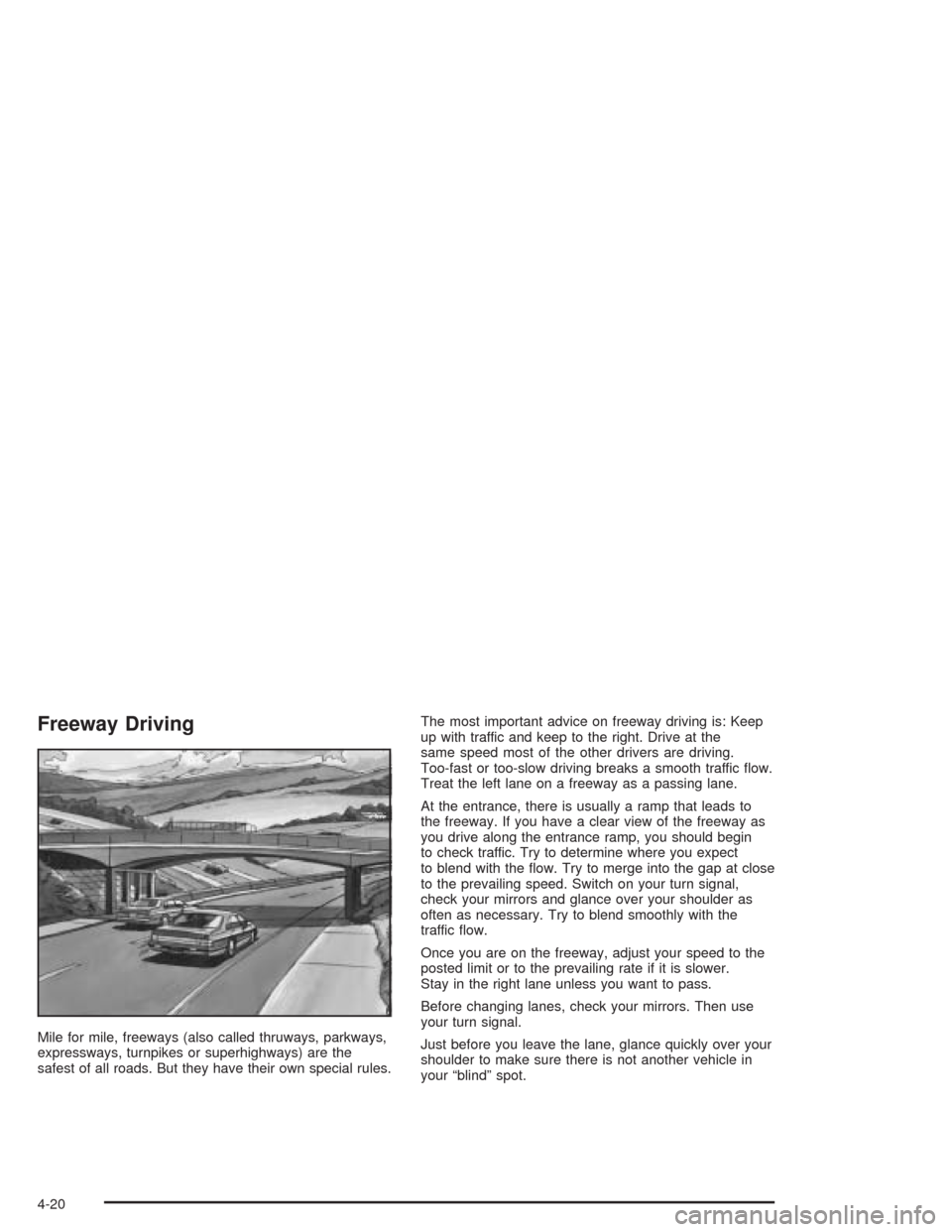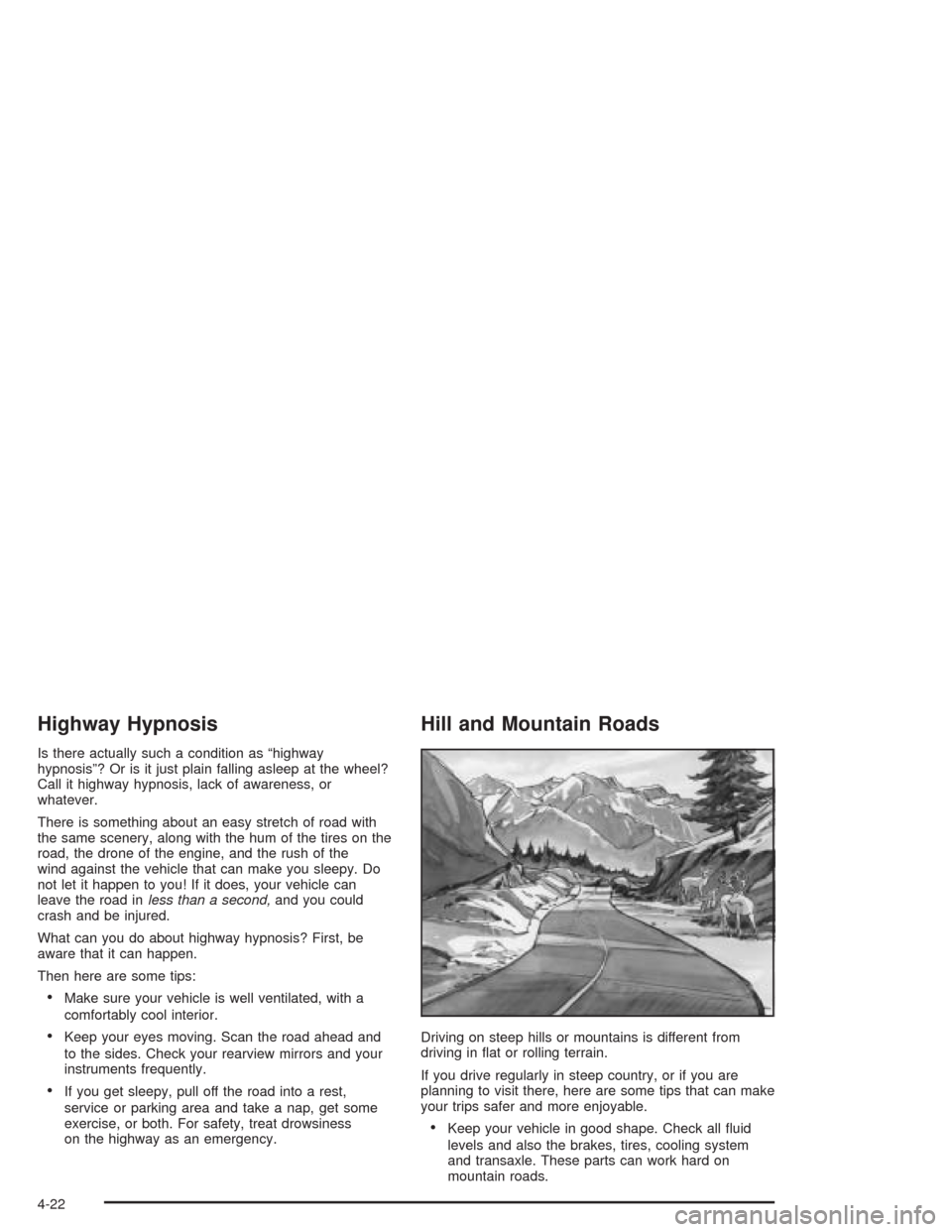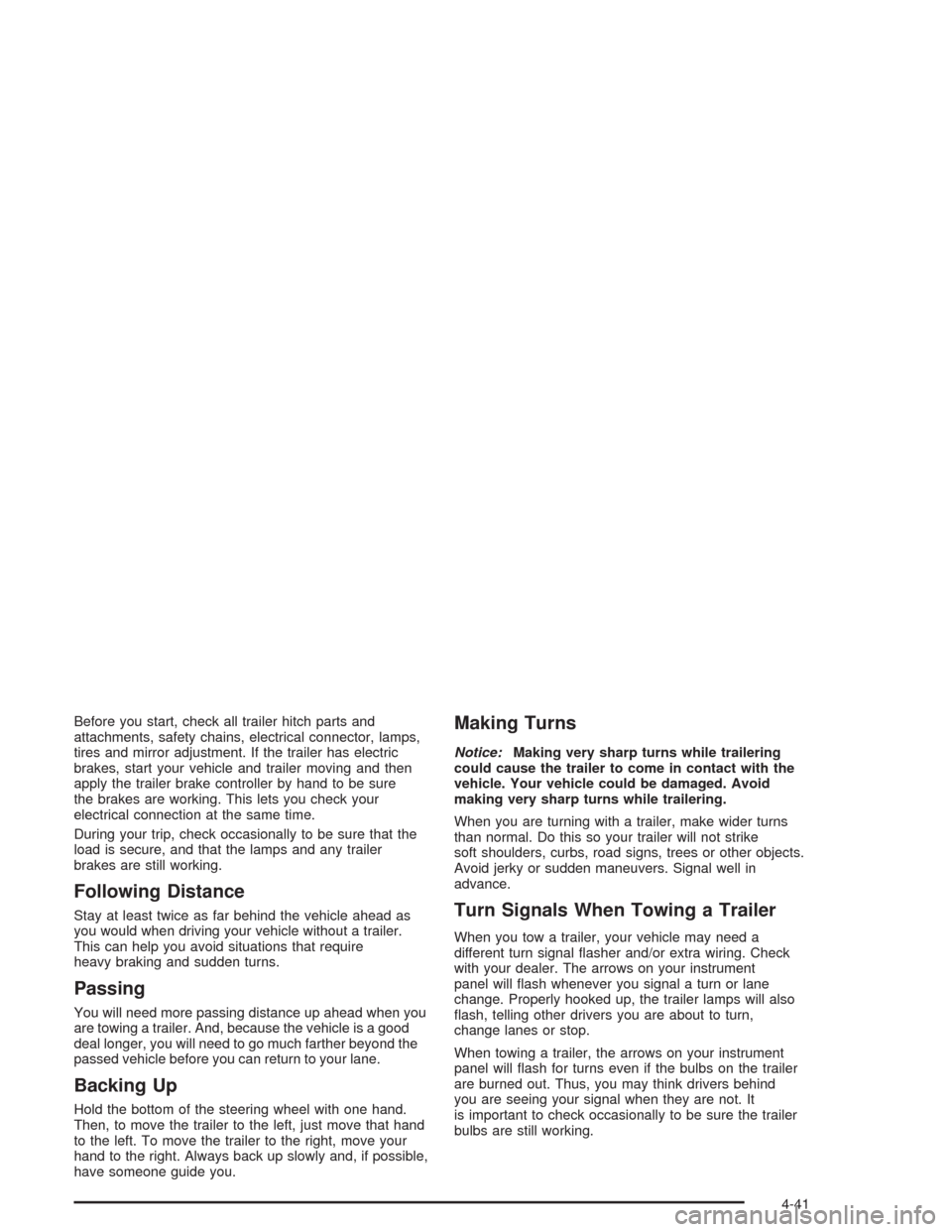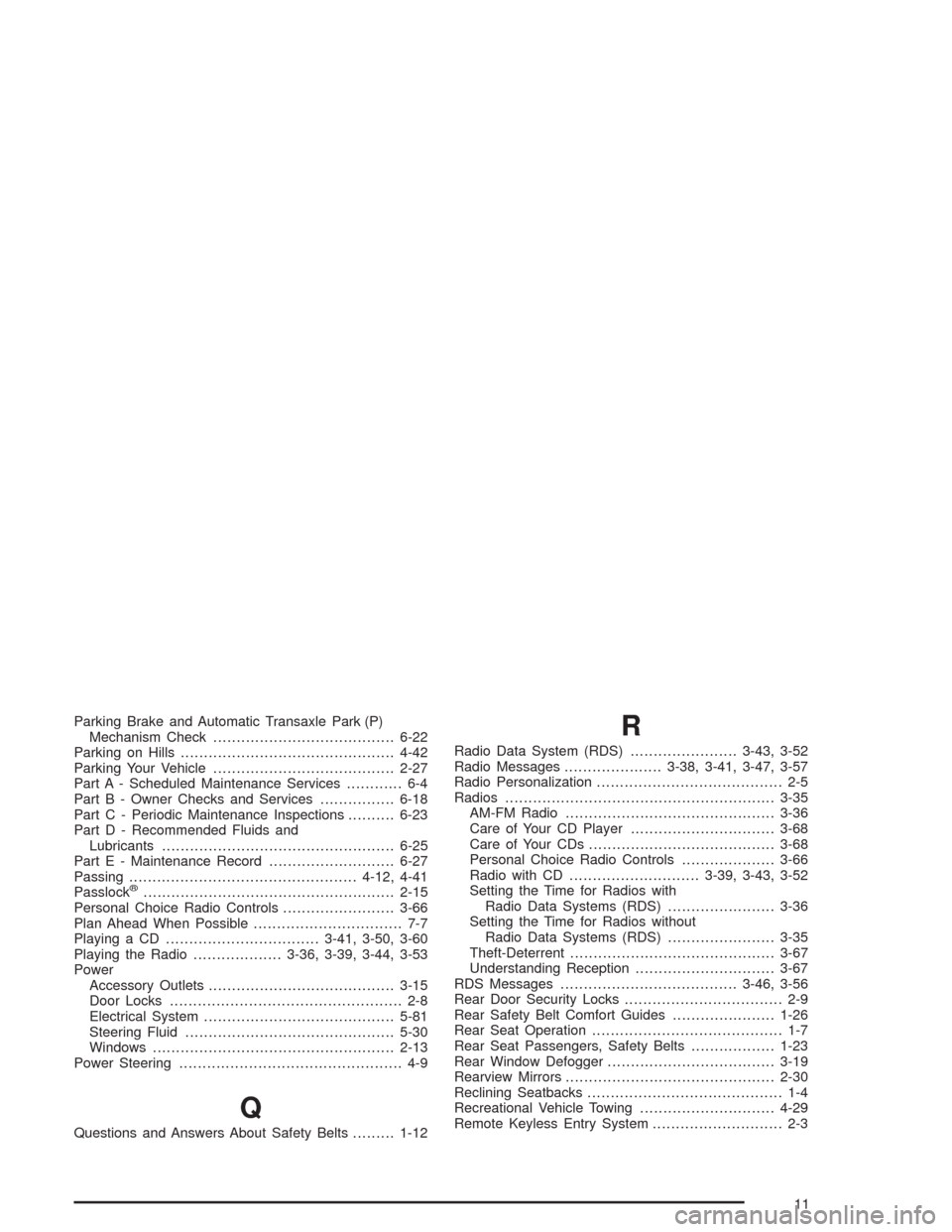2004 CHEVROLET CAVALIER mirror
[x] Cancel search: mirrorPage 181 of 354

Here are some tips on night driving.
Drive defensively.
Do not drink and drive.
Adjust your inside rearview mirror to reduce the
glare from headlamps behind you.
Since you can not see as well, you may need to
slow down and keep more space between you
and other vehicles.
Slow down, especially on higher speed roads. Your
headlamps can light up only so much road ahead.
In remote areas, watch for animals.
If you are tired, pull off the road in a safe place
and rest.
No one can see as well at night as in the daytime. But
as we get older these differences increase. A
50-year-old driver may require at least twice as much
light to see the same thing at night as a 20-year-old.
What you do in the daytime can also affect your
night vision. For example, if you spend the day in bright
sunshine you are wise to wear sunglasses. Your
eyes will have less trouble adjusting to night. But if you
are driving, do not wear sunglasses at night. They
may cut down on glare from headlamps, but they also
make a lot of things invisible.You can be temporarily blinded by approaching
headlamps. It can take a second or two, or even several
seconds, for your eyes to readjust to the dark. When
you are faced with severe glare (as from a driver
who does not lower the high beams, or a vehicle with
misaimed headlamps), slow down a little. Avoid
staring directly into the approaching headlamps.
Keep your windshield and all the glass on your vehicle
clean — inside and out. Glare at night is made much
worse by dirt on the glass. Even the inside of the glass
can build up a �lm caused by dust. Dirty glass makes
lights dazzle and �ash more than clean glass would,
making the pupils of your eyes contract repeatedly.
Remember that your headlamps light up far less of a
roadway when you are in a turn or curve. Keep
your eyes moving; that way, it is easier to pick out dimly
lighted objects. Just as your headlamps should be
checked regularly for proper aim, so should your eyes
be examined regularly. Some drivers suffer from
night blindness — the inability to see in dim light — and
are not even aware of it.
4-15
Page 186 of 354

Freeway Driving
Mile for mile, freeways (also called thruways, parkways,
expressways, turnpikes or superhighways) are the
safest of all roads. But they have their own special rules.The most important advice on freeway driving is: Keep
up with traffic and keep to the right. Drive at the
same speed most of the other drivers are driving.
Too-fast or too-slow driving breaks a smooth traffic �ow.
Treat the left lane on a freeway as a passing lane.
At the entrance, there is usually a ramp that leads to
the freeway. If you have a clear view of the freeway as
you drive along the entrance ramp, you should begin
to check traffic. Try to determine where you expect
to blend with the �ow. Try to merge into the gap at close
to the prevailing speed. Switch on your turn signal,
check your mirrors and glance over your shoulder as
often as necessary. Try to blend smoothly with the
traffic �ow.
Once you are on the freeway, adjust your speed to the
posted limit or to the prevailing rate if it is slower.
Stay in the right lane unless you want to pass.
Before changing lanes, check your mirrors. Then use
your turn signal.
Just before you leave the lane, glance quickly over your
shoulder to make sure there is not another vehicle in
your “blind” spot.
4-20
Page 188 of 354

Highway Hypnosis
Is there actually such a condition as “highway
hypnosis”? Or is it just plain falling asleep at the wheel?
Call it highway hypnosis, lack of awareness, or
whatever.
There is something about an easy stretch of road with
the same scenery, along with the hum of the tires on the
road, the drone of the engine, and the rush of the
wind against the vehicle that can make you sleepy. Do
not let it happen to you! If it does, your vehicle can
leave the road inless than a second,and you could
crash and be injured.
What can you do about highway hypnosis? First, be
aware that it can happen.
Then here are some tips:
Make sure your vehicle is well ventilated, with a
comfortably cool interior.
Keep your eyes moving. Scan the road ahead and
to the sides. Check your rearview mirrors and your
instruments frequently.
If you get sleepy, pull off the road into a rest,
service or parking area and take a nap, get some
exercise, or both. For safety, treat drowsiness
on the highway as an emergency.
Hill and Mountain Roads
Driving on steep hills or mountains is different from
driving in �at or rolling terrain.
If you drive regularly in steep country, or if you are
planning to visit there, here are some tips that can make
your trips safer and more enjoyable.
Keep your vehicle in good shape. Check all �uid
levels and also the brakes, tires, cooling system
and transaxle. These parts can work hard on
mountain roads.
4-22
Page 207 of 354

Before you start, check all trailer hitch parts and
attachments, safety chains, electrical connector, lamps,
tires and mirror adjustment. If the trailer has electric
brakes, start your vehicle and trailer moving and then
apply the trailer brake controller by hand to be sure
the brakes are working. This lets you check your
electrical connection at the same time.
During your trip, check occasionally to be sure that the
load is secure, and that the lamps and any trailer
brakes are still working.
Following Distance
Stay at least twice as far behind the vehicle ahead as
you would when driving your vehicle without a trailer.
This can help you avoid situations that require
heavy braking and sudden turns.
Passing
You will need more passing distance up ahead when you
are towing a trailer. And, because the vehicle is a good
deal longer, you will need to go much farther beyond the
passed vehicle before you can return to your lane.
Backing Up
Hold the bottom of the steering wheel with one hand.
Then, to move the trailer to the left, just move that hand
to the left. To move the trailer to the right, move your
hand to the right. Always back up slowly and, if possible,
have someone guide you.
Making Turns
Notice:Making very sharp turns while trailering
could cause the trailer to come in contact with the
vehicle. Your vehicle could be damaged. Avoid
making very sharp turns while trailering.
When you are turning with a trailer, make wider turns
than normal. Do this so your trailer will not strike
soft shoulders, curbs, road signs, trees or other objects.
Avoid jerky or sudden maneuvers. Signal well in
advance.
Turn Signals When Towing a Trailer
When you tow a trailer, your vehicle may need a
different turn signal �asher and/or extra wiring. Check
with your dealer. The arrows on your instrument
panel will �ash whenever you signal a turn or lane
change. Properly hooked up, the trailer lamps will also
�ash, telling other drivers you are about to turn,
change lanes or stop.
When towing a trailer, the arrows on your instrument
panel will �ash for turns even if the bulbs on the trailer
are burned out. Thus, you may think drivers behind
you are seeing your signal when they are not. It
is important to check occasionally to be sure the trailer
bulbs are still working.
4-41
Page 293 of 354

Fuses Usage
APO Accessory Power Outlet
RFA BATT Remote Keyless Entry System
MIR/DLCPower Mirror/Diagnostic Link
Connector
LT HDLP Left Headlamp
RDO/INTLP Radio, Interior Lamps, OnStar
®
RT HDLP Right Headlamps
CLSTR Instrument Panel Cluster
EXT LP Exterior Lamps
CIG Cigarette Lighter
FOG Fog Lamps
HORN Horn
Blank Not Used
Blank Not Used
STOP/HZD Stop Lamps, Hazard Lamps
Fuses Usage
Blank Not Used
Blank Not Used
RR DEFOG Rear Window Defogger
PWR ACC Power Door Locks
Blank Not Used
Blank Not Used
Blank Not Used
O2 HTR Oxygen Sensor Heater
HVAC Climate Control System
WIPER Windshield Wiper
BCM Body Control Module
AMPL Audio Ampli�er
PWR WDO Power Windows, Sunroof
RELAY DRL Daytime Running Lamps (Relay)
Blank Not Used
5-83
Page 348 of 354

Manual Transaxle Check..................................6-19
Manual Windows............................................2-12
Map Lamps....................................................3-14
Matching Transmitter(s) to Your Vehicle............... 2-6
Mexico, Central America and Caribbean Islands/
Countries (Except Puerto Rico and U.S. Virgin
Islands) – Customer Assistance....................... 7-5
Mirrors
Manual Rearview Mirror................................2-30
Outside Breakaway Mirror.............................2-31
Outside Convex Mirror.................................2-31
Outside Power Mirrors..................................2-30
Outside Remote Control Mirror......................2-30
MyGMLink.com................................................ 7-3
N
New Vehicle Break-In......................................2-16
Normal Maintenance Replacement Parts............5-86
O
Odometer......................................................3-22
Off-Road Recovery..........................................4-11
Oil
Engine.......................................................5-13
Pressure Light.............................................3-32Older Children, Restraints................................1-29
Online Owner Center........................................ 7-3
OnStar
®Personal Calling.................................2-33
OnStar®Services............................................2-32
OnStar®System.............................................2-32
OnStar®Virtual Advisor....................................2-33
Opening a Rear Door When the Security
Lock is On................................................... 2-9
Operation......................................................3-16
Other Warning Devices...................................... 3-5
Outlet Adjustment............................................3-19
Outside
Breakaway Mirrors.......................................2-31
Convex Mirror.............................................2-31
Power Mirrors.............................................2-30
Remote Control Mirror..................................2-30
Overseas – Customer Assistance........................ 7-4
Owners, Canadian............................................... ii
Owner’s Information........................................7-12
P
Park (P)
Shifting Into................................................2-26
Shifting Out of............................................2-27
Parking
Brake........................................................2-25
Over Things That Burn.................................2-28
10
Page 349 of 354

Parking Brake and Automatic Transaxle Park (P)
Mechanism Check.......................................6-22
Parking on Hills..............................................4-42
Parking Your Vehicle.......................................2-27
Part A - Scheduled Maintenance Services............ 6-4
Part B - Owner Checks and Services................6-18
Part C - Periodic Maintenance Inspections..........6-23
Part D - Recommended Fluids and
Lubricants..................................................6-25
Part E - Maintenance Record...........................6-27
Passing.................................................4-12, 4-41
Passlock
®......................................................2-15
Personal Choice Radio Controls........................3-66
Plan Ahead When Possible................................ 7-7
Playing a CD.................................3-41, 3-50, 3-60
Playing the Radio...................3-36, 3-39, 3-44, 3-53
Power
Accessory Outlets........................................3-15
Door Locks.................................................. 2-8
Electrical System.........................................5-81
Steering Fluid.............................................5-30
Windows....................................................2-13
Power Steering................................................ 4-9
Q
Questions and Answers About Safety Belts.........1-12
R
Radio Data System (RDS).......................3-43, 3-52
Radio Messages.....................3-38, 3-41, 3-47, 3-57
Radio Personalization........................................ 2-5
Radios..........................................................3-35
AM-FM Radio.............................................3-36
Care of Your CD Player...............................3-68
Care of Your CDs........................................3-68
Personal Choice Radio Controls....................3-66
Radio with CD............................3-39, 3-43, 3-52
Setting the Time for Radios with
Radio Data Systems (RDS).......................3-36
Setting the Time for Radios without
Radio Data Systems (RDS).......................3-35
Theft-Deterrent............................................3-67
Understanding Reception..............................3-67
RDS Messages......................................3-46, 3-56
Rear Door Security Locks.................................. 2-9
Rear Safety Belt Comfort Guides......................1-26
Rear Seat Operation......................................... 1-7
Rear Seat Passengers, Safety Belts..................1-23
Rear Window Defogger....................................3-19
Rearview Mirrors.............................................2-30
Reclining Seatbacks.......................................... 1-4
Recreational Vehicle Towing.............................4-29
Remote Keyless Entry System............................ 2-3
11